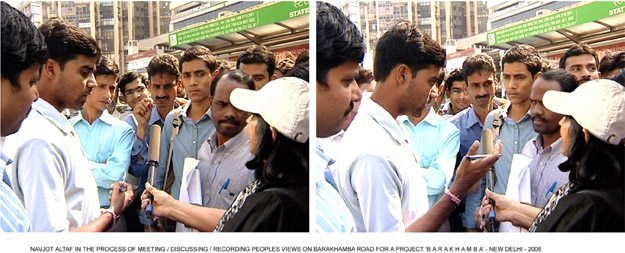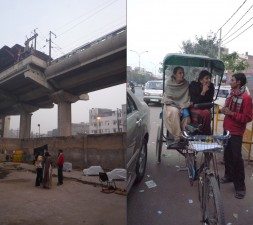Title: Measures Of Inter Communication
We forget that in all cultures there exist philosophies, beliefs, myths, stories, and rituals, related to the earth as a cosmic center/ecology/ people’s relationship with their environment, which affects circumstances of living. But in the lack of a long-term vision and critical perspective to understand how to sustain /acquire eco-functional systems in possible sustainable developments, there are ecological crisis worldwide – where the relationship continues to be that of human domination giving rise to oppressive cultural, socio-political and economic systems affecting the quality of life on earth and further promoting subjectivity of individualism and inequality.
I am interested in early philosophies, historical and the critical perspective to work towards change and possible relationships between nature and culture and relationships between people from diverse cultures, as I believe that connectivity encourages diversity, which calibrates intercommunication.
As an installation, video artist, also working with Adivasi /indigenous artists and community members (ongoing Nalpar /Handpump and Pilla Gudi /temples for children projects since 1997) in Bastar, Central India, what intrigues me about interactive aspects of collaboration is when the work emerges out of an extended dialogical interaction. Secondly, looking at art in a public domain – I believe that it becomes extremely important to visualize the process inclusive of people. My projects employ this methodology.
My recent project ‘B A R A K H A M B A 2 0 0 8’ in New Delhi (On Barakhamba Road over 100, century old trees were cut by the Delhi Metro Rail Corporation to accommodate Metro construction work) examined the complex relationship/differences between the urban environments, city development programmes, those who plan / build infrastructure / analyzers /advisors/ and the people, who are not a homogeneous body. Lay people using main streets, by-lanes, parking lots of Barakhamba – pedestrians, the commuters from the Metro and public buses, shopkeepers, taxi, rickshaw and car drivers, those who work in the high-rise offices at Barakhamba, architects, town planners, alongside with environmentalists, bio-diversity scientists, urban resource researchers, urban economists, social activists, journalists and artists. Included are authority figures involved in creating and maintaining the locality’s infrastructures: officials from the Delhi Metro Rail Corporation, the New Delhi Municipal Corporation and the traffic police.
This process of engaging and interacting with people on the site itself, as well as in their areas of work and related locations, allowed me to engage with the city’s larger socio-political concerns and complexities. It helped build mutual alliances with some of the people. For me it is necessary that the dialogue becomes a two-way negotiation inviting multiple viewpoints. The entire process brought a number of people into conversation at various stages and levels. To understand this work in a larger context is to recognize that process and all associated activities.
Double channel projections of video documentation of above mentioned participants’ voices, opinions, perceptions of environment, ecology and public art alongside the third projection of the unedited, on-site conversations between the participants / viewers and myself raised questions about the possibilities of ‘actual change’ through such a mode of art practice.
The second phase ‘B A R A K H A M B A 2 0 1 0’ looks into the plausibility of working towards bringing in actual change on the site. In the political scenario where there have been ongoing exercises in cultural censorship by political parties and the politicians along with conservative fundamentalists who have targeted women, artists, minority religious and the indigenous population, my art making processes emphasize to envision ways of interaction to broaden intellectual understanding.
‘MOTORNAMA ROSHANARA’ by Mumbai based artists Shina Anand and Ashok takes you on a ride through the industrial district around Roshanara road in Delhi. One sees cycle-rickshaws and ricksha-wallas as narrators and guides. We come across various sites and histories of the “industrial age” in the city, and its related narratives of automation, pollution, labour and closure. Sites visited include houses in the shadow of the new metro, a hundred year-old ice factory, a car-cover karkhana, a derelict cinema, motor repair, a printing press transported from Lahore, a famous clock-tower, amongst others.
Roshanara road was till 20 years ago the centre of the industrial city of Delhi, with Transport Nagar, the old Grand Trunk road, Sabzi Mandi, the Beej (seed) Market and related infrastructure all crowded around it. Old residents claim that it was not only Asia’s largest engine repair market, but also an upper-class hangout with Palace Cinema and restaurants and other markets flourishing.In a series of court-initiated “anti-pollution” drives in 1996 and 2000, Roshanara road’s small and large industries were forced out of spaces that they had occupied since partition. Change in transport technology changed, and the repair industries could not compete. In effect, the “motor” of industrial progress was moved out of the city.
Cycle rickshaws have survived this history. Not in a sense that they emerged victorious, but in that despite court orders, police brutality and resistance from resident associations, their numbers in the city have grown from about 20,000 in the early 1980’s to more than 900,000 today. The vast majority of pullers live on the street, or in “informal” situations. Recently, cycle-rikshaws have found favour with green groups and the eco-lobby, as a “non-polluting” form of transport. This discourse largely does not include considerations of where rickshawallas will live, their health and other needs, etc.
‘Our project then entered this historical and regulatory landscape, and offered members of the public: both locals and visitors, a tour of this landscape of lost old machines, labour, bodily risk and local histories. We worked with 25 rickshawallas who lived in and around Roshanara Road, for over two months. Workshops and meeting were held in the Roshanara Garden and other locations in the area’. ( Shaina Anand )
Sheba Chhachhi for a decade or so has been thinking about the intersection between cultural systems and ecological systems within Indian/Asian culture. As an installation artist and photographer, she seeks to recuperate a rich ‘eco philosophy’, one which conceptualizes the environment as a field of dynamic play across both terrestrial and symbolic-celestial networks; and the historical and metaphoric relationships which mediate between human beings and nature as ranging from the meteorological to the mytho-poetic, the religious to the mercantile. ‘I believe that this expanded view needs to be recuperated from mechanical ritual and short term self interest’.
 In the video installation ‘Neelkanth: poison /nectar’ (2003) and ‘The Water Diviner’ (2009), the mythic and the social conjoin to open reflection on questions of urbanization, waste, cultural memory and the possibilities of transformation. The terrible condition of the River Jamuna, which flows through the city she lives in, Delhi, has been an ongoing concern and finds expression in a series of works. Women, mythologized or ordinary, are key protagonists appearing as displaced, dispossessed urban survivors, mutants, goddesses ..
In the video installation ‘Neelkanth: poison /nectar’ (2003) and ‘The Water Diviner’ (2009), the mythic and the social conjoin to open reflection on questions of urbanization, waste, cultural memory and the possibilities of transformation. The terrible condition of the River Jamuna, which flows through the city she lives in, Delhi, has been an ongoing concern and finds expression in a series of works. Women, mythologized or ordinary, are key protagonists appearing as displaced, dispossessed urban survivors, mutants, goddesses ..
‘These current preoccupations flow out of an engagement in the women’s movement, as activist/artist, and long time chronicler, since the early 80’s. I work with a range of media and processes, and in a variety of contexts – galleries, public institutions, progressive movements and activist groups – however photography/photo-based artwork remains the core of my practice. Today I bear witness to the effects of globalization, the rupture of personal and collective memory, and seek to affirm the existence of an alternative imaginary through my practice’. (Sheba Chhachhi)
WEAD MAGAZINE ISSUE No. 1, CREATING CONNECTIONS
Published August 2010


